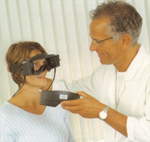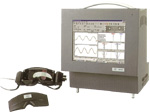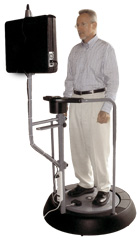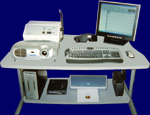CPT Codes for VNG
| CPT-Code | Description | Charge | Units | Reimbursement |
|---|---|---|---|---|
| 99214 | Office Visit | $100.00 |
1 |
$60.00 |
| 92541 | Spontaneous | $150.00 |
1 |
$55.00 |
| 92542 | Positional | $150.00 |
1 |
$55.00 |
| 92543 | Caloric ($25 per Caloric/ 4 calorics) | $300.00 |
4 |
$100.00 |
| 92544 | OPK | $150.00 |
1 |
$45.00 |
| 92545 | Tracking | $200.00 |
1 |
$40.00 |
| 92546 | Rotary Chair Only | $200.00 |
1 |
$84.60 |
| 92547 | Vertical Record | $100.00 |
1 |
$5.00 |
| The average Medicare reimbursement for VNG testing (NOT INCLUDING CPT-92546) is approximately $400. If you are a physician, the test can be performed by any of your staff. If you are not a physician, the test MUST be performed by an Audiologist or Physician. See the section What They Don't Want You To Know regarding CPT-92546. | ||||
| CPT-Code | Description | Charge | Units | Reimbursement |
|---|---|---|---|---|
| 99214 | Office Visit | $100.00 |
1 |
$60.00 |
| 92541 | Spontaneous | $150.00 |
1 |
$55.00 |
| 92542 | Positional | $150.00 |
1 |
$56.07 |
| 92547 | Vertical Record | $100.00 |
1 |
$48.83 |
| 92700 | Positional Posterior Canalithiasis | $35.00 |
||
| 92700 | Use of Video Goggle Recording | $35.00 |
||
| Reimbursement for Epley maneuver in office is approximately $290 per session. This procedure can be performed in under 20 minutes. | ||||
Coding and Billing Information
Vestibular Function Tests with Recording (e.g. ENG) and Medical Diagnostic Evaluation
Following each code are three descriptions of various tests done with the Secure Balance™ Systems.
- Name of the test as listed in the CPT codes.
- A single sentence often used in medical billing.
- An extended paragraph would be appropriate for appending to a super bill.
| CPT 92541 | Spontaneous nystagmus test, including gaze and fixation nystagmus, with recording |
|---|---|
| Brief | These nystagmus tests document and measure the inability of the eyes to maintain a static position as a result of peripheral, CNS or congenital abnormality. |
| Extended | These nystagmus tests document and measure the inability of the eyes to maintain a static position as a result of peripheral, CNS or congenital abnormality. The tests are conducted with the eyes open and closed and in 'eyes forward' as well as 'eyes right' and 'eyes left' positions. |
| CPT 92542 | Positional nystagmus test, minimum of four positions, with recording |
|---|---|
| Brief | These spontaneous nystagmus tests document and measure the inability of the eyes to maintain a static position when the head is in different positions. |
| Extended | These spontaneous nystagmus tests document and measure the inability of the eyes to maintain a static position when the head is in different positions. These tests are valuable to document and quantify patient complaints of dizziness in certain situations or positions. Moreover, they are sometimes helpful to localize the abnormality as CNS or peripheral. |
| CPT 92543 | Caloric vestibular test, each irrigation (binaural bithermal stimulation constitutes four tests), with recording |
|---|---|
| Brief | The caloric tests evaluate the viability of the peripheral end organs by stimulating them with warm and cool water. |
| Extended | The caloric tests evaluate the viability of the peripheral end organs by stimulating them with warm and cool water while the patient’s eyes are closed. The resulting dizziness and nystagmus is taken as an index of the viability of the organ. The eyes are then opened to evaluate the ability of the CNS to visually suppress inappropriate dizziness and nystagmus. |
| CPT 92544 | Optokinetic nystagmus test, bidirecitonal, foveal or peripheral stimulation, with recording |
|---|---|
| Brief | The optokinetic test documents and measures eye movements as the patient watches a series of targets moving simultaneously. |
| Extended | The optokinetic test documents and measures eye movements as the patients watches a series of targets moving simultaneously to the right and then to the left. The optokinetic mechanism is at work when the visual movement in one direction encompasses more than a single point. |
| CPT 92545 | Oscillating tracking test, with recording |
|---|---|
| Brief | This test evaluates the ability of the patient to keep a moving visual target registered on the fovea. |
| Extended | This test evaluates the ability of the patient to keep a moving visual target registered on the fovea. The patient watches a light as it moves back and forth in a smooth pendular fashion. The computer computes the gain (target velocity divided by eye velocity) and compares the gain to age matched norms. |
| CPT 92546 | Sinusoidal vertical axis rotational testing |
|---|---|
| Brief | This is a computerized test of the Vestibulo-Ocular Reflex (VOR), the neural mechanism that keeps a visual image registered on the fovea during head movement. |
| Extended | This is a computerized test of the Vestibulo-Ocular Reflex (VOR), the neural mechanism that keeps a visual image registered on the fovea during head movement. It evaluates the three functional components of the VOR system: the peripheral end organ, the vestibular nuclei of the brain stem and the higher central vestibular connections. The test is accomplished by having the patient shake his head "no" and "yes" while wearing EOG electrodes that monitor eye position and a small angular velocity sensor that measures head velocity. From this data the computer computes three characteristics of the VOR: gain (ratio of eye velocity to head velocity), phase (the number of degrees by which the eye ‘misses’ the target), and asymmetry (a comparison of gain moving right with gain moving left). This information is useful for evaluating patients with balance disorders. |
| CPT 92546 | Sinusoidal vertical axis rotational testing |
|---|---|
| Brief | This is a computerized slow harmonic acceleration rotation test to evaluate the integrity of the vestibular-ocular system. |
| Extended | This is a computerized slow harmonic acceleration rotation test to evaluate the integrity of the vestibular-ocular system. The test lasts for 30-40 minutes and is completely run under computer control. This is an essential part in the evaluation of the dizzy patient as it reflects the relationship between natural head and eye movements involved in the balance mechanism. |
| CPT 92547 | Use of vertical electrodes or Video in any of all of the above tests to record vertical eye movement counts as 1 additional test. |
|---|
| CPT 92458 | Computerized Dynamic Posturography |
|---|---|
| Description | This is a computerized test that allow various systems that contribute to equilibrium to be assessed. |
| CPT 99354 | PROLONGED CONTACT FACE TO FACE (1st Hour) for patient education e.g. Explaining Menieres disease |
|---|---|
| CPT 99355 | PROLONGED CONTACT FACE TO FACE (each additional 30 min.) for patient education e.g. Explaining Menieres disease |
| CPT 99358 | PROLONGED EM SERVICE NOT FACE TO FACE (1st Hour) when discussing patient management with Doctor (document well) |
| CPT 99359 | PROLONGED EM SERVICE NOT FACE TO FACE (each additional 30 min.) when discussing patient management with Doctor (document well) |
| CPT 99375 | CARE PLAN OVERSIGHT SERVICE 30 - 60 MINS PER 30 DAYS (document well) |
| CPT 97110 | Therapeutic procedure 1 or more areas, each 15 minutes, therapeutic exercise to develop strength, range of motion |
|---|---|
| CPT 97112 | Neuromuscular reeducation of movement, each 15 minutes |
| CPT 97530 | Therapeutic activities, direct (one on one) patient contact by the provider (use of dynamic activities to improve functional performance) each 15 minutes. |
|---|---|
| CPT 97535 | Self care / home management training (e.g. activities of daily living (ADL) and compensatory training, meal preparation, safety procedures, and instructions in use of adaptive equipment) direct (one on one) contact by provider, each 15 minutes. |
| CPT 97537 | Community / work reintegration training (e.g. shopping, transportation, money management, avocational activities and / or work environment / modification analysis, work task analysis), direct (one on one) contact by provider, each 15 minutes |
| CPT 97750 | Physical performance test or measurement (e.g. musculoskeletal, functional capacity) with written report, each 15 minutes. |
| CPT 97532 | Development of cognitive skills to improve attention, memory, problem solving, includes compensatory training and / or sensory integrative activities, direct (one on one) patient contact by the provider, each 15 minutes. |
THE CONTENTS AND MATERIAL CONTAINED HEREIN ARE SUBJECT TO CHANGE BY A VARIETY OF GOVERNMENT AGENCIES, INCLUSIVE OF MEDICARE. IT IS YOUR RESPONSIBILITY TO CONTACT ANY OF THE NECESSARY GOVERNMENT AGENCIES, EITHER LOCAL, STATE AND/OR FEDERAL, TO VERIFY GUIDELINES, COMPLIANCE REQUIREMENTS, FEE SCHEDULES, BILLING REQUIREMENTS AND REIMBURSEMENT AMOUNTS THAT MAY EFFECT YOUR SPECIFIC BUSINESS. THE MATERIALS PROVIDED HAVE BEEN RESEARCHED AND ARE PREPARED PROFESSIONALLY AND MAY NOT BE USED FOR DISTRIBUTION. THESE MATERIALS ARE PROVIDED AS A REFERENCE AND FOR INFORMATIONAL PURPOSES ONLY.



